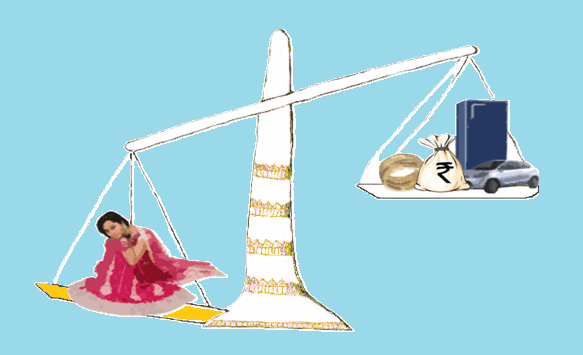In Hindu culture, Stridhan refers to the property owned by a woman that is separate from her husband’s property. The term Stridhana occurred amongst the Smritis and in the Dharmasutra of Gautam and means women’s property. In modern pure Hindu law, the term stridhana denoted not only the specific kinds of property enumerated in the Smritis but also other species of property acquired and owned by women over which she had absolute control and she formed the stock of descent in respect of such property.
This property includes all kinds of movable and immovable assets, such as jewelry, cash, deposits, and more. Generally, these assets are received by a woman from her parents or relatives or acquired by her in her own right during or after marriage. The term “stridhan” has been used for centuries and is mentioned in ancient Hindu texts and laws. It is considered the absolute property of a woman, and she has complete control over it.
It is worth noting that stridhan is different from the dowry, which is given by the woman’s family to the husband’s family at the time of marriage. The definition and sources of stridhan may vary based on the region and community. Stridhana differs from dowry in the way that it is a voluntary gift given to a woman before or after her marriage and has no element of coercion. Women have an absolute right over their stridhana. Any kind of movable and immovable in any form may constitute stridhana.
How stridhana is acquired?
As for how stridhan is acquired, according to section 14 of the Hindu Succession Act of 1956, property obtained by women from the following sources is her absolute property:
- Gifts received before marriage, after marriage, and during marriage;
- Property received as her exclusive share during the partition of family property;
- Gifts and bequests from strangers;
- Property acquired by inheritance;
- property acquired by adverse possession;
- Property given instead of maintenance;
- Property acquired by mechanical arts;
- Property obtained by compromise;
- property purchased with stridhana or savings with income of stridhana; and
- Property acquired from sources other than those mentioned above.
Application under allied law
- As per the Hindu Succession Act, of 1956 and the Hindu Marriage Act, of 1955, women in India are entitled to their stridhan, which refers to the assets and wealth that a woman brings to her husband’s household at the time of marriage. Even if the stridhan is kept with the husband or in-laws, they are considered trustees and are legally obliged to return it upon the woman’s request.
- Moreover, the Domestic Violence Act, of 2005, provides women with the right to their stridhana in cases of domestic abuse. The act states that if a woman seeks recovery of her stridhana, the magistrate may direct the respondent to return it to her possession.
- The Domestic Violence Act, under section 18 (ii), further states that women are entitled to receive their stridhan, jewelry, clothes, and other necessary items. The term ‘economic abuse’ is used in this act to refer to the withholding of a woman’s stridhan by her husband or in-laws, which can have a severe impact on her financial stability and social status.
Case Law
Bhai Sher Jang Singh v/s Smt Virinder Kaur
The Punjab and Haryana High Court has made a significant ruling regarding marriage customs. According to the court, if the bride’s family offers assets at the time of marriage, it is the responsibility of the groom’s side to return them upon request. If they refuse to do so, they may face punishment by a court of law.
In a recent case, Bhai Sher Jang Singh and his family were found to have violated Section 406 of the IPC, which is the criminal breach of trust. This violation pertains to Virinder Kaur’s stridhana, which she had entrusted to her husband for safekeeping. The court found that Singh and his family had not returned the assets to the bride’s family upon request, despite being obligated to do so. This ruling is a significant step towards ensuring that marriage customs and traditions are upheld and respected by all parties involved.
Debi Mangal Prasad Singh v/s Mahadeo Prasad Singh (1912)
This particular case was observed by the Allahabad High Court, which stated that according to both the Mitakshara and Dayabhaga schools, it is a well-established legal principle that any share obtained by a female from partition is not considered as stridhana but as a women’s estate. The term “stridhana” refers to a woman’s property that she acquires either through inheritance, gift, or personal earnings.
However, after the passing of the Hindu Succession Act of 1956, the shared property obtained from partition was regarded as absolute property or stridhana. This means that the female becomes the owner of the absolute property and has complete rights to alienate it. She can gift, sell, lease, exchange, mortgage, or do whatever she chooses with the possession. This legal interpretation enables women to have full control over their property and exercise their rights to dispose of it according to their wishes.
Conclusion
The Hindu Succession Act of 1956 represents a significant milestone in the history of property rights for Hindu women. It is noteworthy because it was enacted at a time when the legal view of women’s rights was changing. Before the Act, the Privy Council’s ruling in Bhugwandee Doobey v. Myna Baee (1869) had established that property acquired by a woman from her husband was not considered her Stridhana, meaning it would be inherited by the heirs of the husband upon her death, rather than by her heirs.
Similarly, in Debi Sahai vs Sheo Shanker Lal And Anr (1900), the Privy Council had held that property obtained by a daughter from her mother was not considered the daughter’s Stridhana, and would therefore passed on to the heirs of the mother, rather than to the heirs of the daughter, upon the mother’s death. By contrast, the Hindu Succession Act of 1956 recognized the right of Hindu women to inherit and own property, regardless of its source. This was a significant victory for women’s rights and helped to rectify centuries of legal discrimination and inequality that have been denied to them for generations as a result of this Act.
It is a monumental step forward in the preservation of women’s rights because it eliminates a woman’s inability to acquire and hold property as its sole owner. Along with the legislation, equal amounts of credit should be provided to the judiciary as well which has provided a liberal interpretation of the provisions of the legislation taking into account the social development of the nation as a whole.
Also Read:
Rights of undertrial prisoners in India
How To Send A Legal Notice In India





Content is very helpful… keep up.